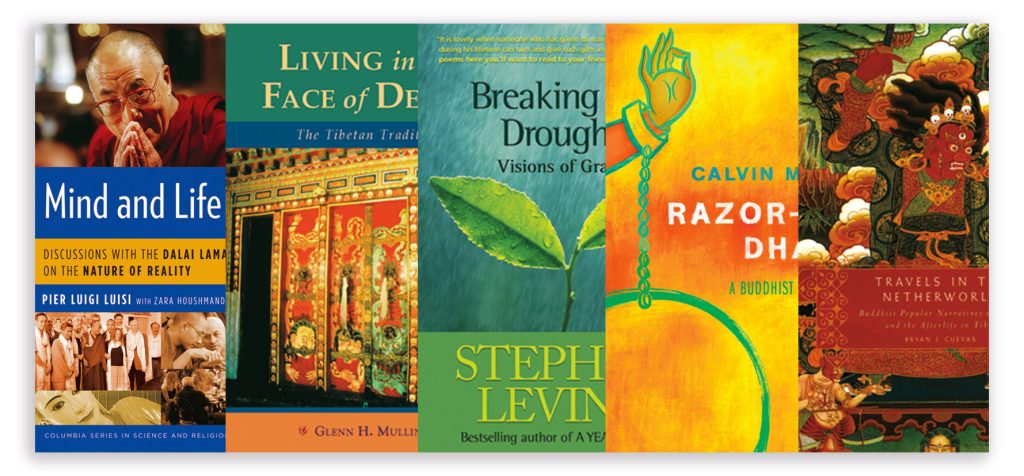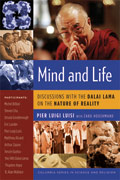 Tenzin Gyatso, the 14th Dalai Lama, is well known for his longstanding interest in science and, in recent years, for his scholarly engagements with scientists at the (now annual) Mind and Life conferences. Mind and Life: Discussions With The Dalai Lama on the Nature of Reality by Pier Luigi Luisi with Zara Houshmand (Columbia University Press, 2008, $24.95 cloth, 209 pp.) documents in narrative form the 2002 conference in Dharamsala, India, which focused on an age-old question—the relationship between life and matter. Though dense scientific jargon occasionally makes for slow going, biochemist Luisi, a conference participant, provides a lively account of the discussions on topics like emergence, complexity, and the human genome. At the same time he never loses sight of the productive tensions at the juncture of science and Buddhism that this event inevitably brings to the fore.
Tenzin Gyatso, the 14th Dalai Lama, is well known for his longstanding interest in science and, in recent years, for his scholarly engagements with scientists at the (now annual) Mind and Life conferences. Mind and Life: Discussions With The Dalai Lama on the Nature of Reality by Pier Luigi Luisi with Zara Houshmand (Columbia University Press, 2008, $24.95 cloth, 209 pp.) documents in narrative form the 2002 conference in Dharamsala, India, which focused on an age-old question—the relationship between life and matter. Though dense scientific jargon occasionally makes for slow going, biochemist Luisi, a conference participant, provides a lively account of the discussions on topics like emergence, complexity, and the human genome. At the same time he never loses sight of the productive tensions at the juncture of science and Buddhism that this event inevitably brings to the fore.
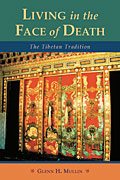 Death, notes Tibetologist Glenn H. Mullin, is a taboo subject in the West, arousing something akin to the delighted aversion that sex inspired in the Victorians. With Living in the Face of Death: The Tibetan Tradition (Snow Lion Publications, 2008, $16.95 paper, 240 pp.), Mullin aims to reverse this trend. In accessible translations of nine texts spanning centuries— including works by the 2nd, 7th, and 13th Dalai Lamas—he looks to Tibetan Buddhism for guidance. His introduction, and the preamble to each piece, are welcome additions, but the translated works themselves are engaging and very readable, providing enduring insight into a human difficulty that is here to stay.
Death, notes Tibetologist Glenn H. Mullin, is a taboo subject in the West, arousing something akin to the delighted aversion that sex inspired in the Victorians. With Living in the Face of Death: The Tibetan Tradition (Snow Lion Publications, 2008, $16.95 paper, 240 pp.), Mullin aims to reverse this trend. In accessible translations of nine texts spanning centuries— including works by the 2nd, 7th, and 13th Dalai Lamas—he looks to Tibetan Buddhism for guidance. His introduction, and the preamble to each piece, are welcome additions, but the translated works themselves are engaging and very readable, providing enduring insight into a human difficulty that is here to stay.
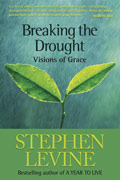 Dying, grieving, and love inhabit the poems of Stephen Levine inBreaking the Drought: Visions of Grace (Larson Publications, 2007, $15.00 paper, 142 pp.), a collection that delves into themes he has often explored as a teacher of meditation and healing practices. Levine invites a Buddhist sensibility into reflective portraits of “red-eyed lime-green frogs,” “the honeycomb of memory,” and other evocative subjects. Dharma-tinged passages (“Another thought thinking itself all by itself / the fragile moment / vanishing in space”) find graceful balance with grasps at poetic passion: “I was a liar, once a thief, never easy in my mind / yet I longed so to know the origin of the grace / on the lips of those who seem to love so well.” Levine’s verse carries the wisdom of a life lived open to vulnerability, greeting the reader with surprising empathy.
Dying, grieving, and love inhabit the poems of Stephen Levine inBreaking the Drought: Visions of Grace (Larson Publications, 2007, $15.00 paper, 142 pp.), a collection that delves into themes he has often explored as a teacher of meditation and healing practices. Levine invites a Buddhist sensibility into reflective portraits of “red-eyed lime-green frogs,” “the honeycomb of memory,” and other evocative subjects. Dharma-tinged passages (“Another thought thinking itself all by itself / the fragile moment / vanishing in space”) find graceful balance with grasps at poetic passion: “I was a liar, once a thief, never easy in my mind / yet I longed so to know the origin of the grace / on the lips of those who seem to love so well.” Levine’s verse carries the wisdom of a life lived open to vulnerability, greeting the reader with surprising empathy.
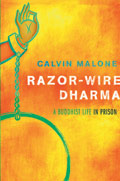 Concealing vulnerability is a survival strategy for many prison inmates. Calvin Malone’s Razor-Wire Dharma: A Buddhist Life in Prison (Wisdom Publications, 2008, $16.96 paper, 228 pp.) is both a candid personal narrative and an inside take on the fast-growing Buddhist movement behind bars. In a series of captivating anecdotes, Malone introduces a diverse cast of cellmates, guards, and family members, reflecting on the challenges—and strategies for skillful means—that each interaction brings. In an environment where violence, racism, and overwhelming regret form the basis of everyday life, where meals “can only be described as questionable” and prisoners’ few rights are routinely ignored, the dharma acquires vivid relevance. While getting through the day is no easy task for Malone, few meditation halls present such unavoidable opportunities to put Buddhism into practice. The book is an inspiration, revealing the great potential that meditation holds for incarcerated communities.
Concealing vulnerability is a survival strategy for many prison inmates. Calvin Malone’s Razor-Wire Dharma: A Buddhist Life in Prison (Wisdom Publications, 2008, $16.96 paper, 228 pp.) is both a candid personal narrative and an inside take on the fast-growing Buddhist movement behind bars. In a series of captivating anecdotes, Malone introduces a diverse cast of cellmates, guards, and family members, reflecting on the challenges—and strategies for skillful means—that each interaction brings. In an environment where violence, racism, and overwhelming regret form the basis of everyday life, where meals “can only be described as questionable” and prisoners’ few rights are routinely ignored, the dharma acquires vivid relevance. While getting through the day is no easy task for Malone, few meditation halls present such unavoidable opportunities to put Buddhism into practice. The book is an inspiration, revealing the great potential that meditation holds for incarcerated communities.
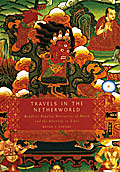 Buddhism is often defended as a rational tradition, based on empirical investigation. While Bryan J. Cuevas, in Travels in the Netherworld: Buddhist Popular Narratives of Death and the Afterlife in Tibet (Oxford University Press, 2008, $65.00 cloth, 216 pp.), does not dispute this view, he conjures a radically different vision of Tibetan Buddhism. Cuevas, a religion professor at Florida State University, turns to a Tibetan literary tradition with roots in the 15th century in which the délok—human beings who claim to have died, visited hell, and returned from the afterlife—narrate their otherworldly experiences. In extended analyses of four such individuals’ accounts—those of a Tibetan housewife, a lama, a young noble woman, and a Buddhist monk—he challenges inherited divides separating elite and folk, monastic and lay. Academic rigor does not get in the way of artful and enticing storytelling.
Buddhism is often defended as a rational tradition, based on empirical investigation. While Bryan J. Cuevas, in Travels in the Netherworld: Buddhist Popular Narratives of Death and the Afterlife in Tibet (Oxford University Press, 2008, $65.00 cloth, 216 pp.), does not dispute this view, he conjures a radically different vision of Tibetan Buddhism. Cuevas, a religion professor at Florida State University, turns to a Tibetan literary tradition with roots in the 15th century in which the délok—human beings who claim to have died, visited hell, and returned from the afterlife—narrate their otherworldly experiences. In extended analyses of four such individuals’ accounts—those of a Tibetan housewife, a lama, a young noble woman, and a Buddhist monk—he challenges inherited divides separating elite and folk, monastic and lay. Academic rigor does not get in the way of artful and enticing storytelling.
Thank you for subscribing to Tricycle! As a nonprofit, we depend on readers like you to keep Buddhist teachings and practices widely available.
